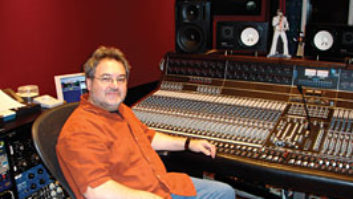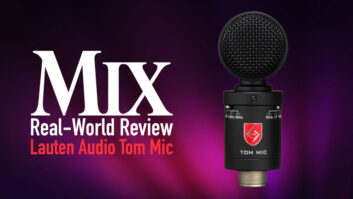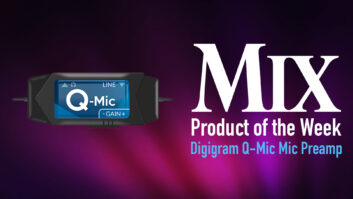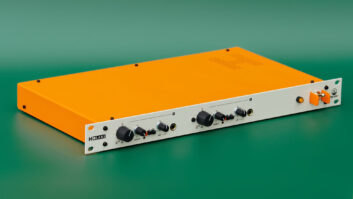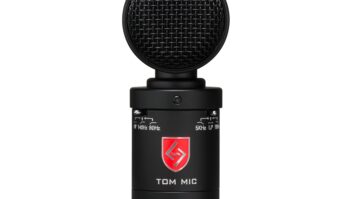
Korby KAT Red
If large-diaphragm condenser mics performed identically to their small-diaphragm cousins, engineers would probably buy the behemoth versions anyway just because they look so cool. But besides the confidence that size and weight bring, recording with a large-diaphragm condenser (LDC) mic offers several practical advantages — and drawbacks — compared to capturing a performance using a small-diaphragm model.

Soundelux e250
In this article, I’ll discuss those pluses and minuses and give a crash course in understanding the microphone specs you should consider when shopping for your next “big buddy.” As you follow along, be sure to check out the accompanying chart that lists important specs for the new crop of LDC mics. Just remember that specs should be considered only as a starting point in your shopping spree. Not all specs are derived using the same methods or reference points, and including such detailed background information — assuming it’s available — in a chart isn’t possible. This article is simply meant to arm you with the tools to separate the wheat from the chaff, and let you know about some interesting new developments in mic design.

Wunder CM7
To prevent the accompanying chart from ballooning this month’s issue of Mix to 400 pages, I’ve limited the included LDC models to those that were announced at or since winter NAMM 2005 (which happened in January of that year). And despite their usefulness in critical recording applications, small-diaphragm condensers and dynamic mics (including those sporting ribbon designs) are also excluded from the chart so you can still lift this magazine without using a crane.

CharterOakE700
CRITICAL MASS
All other factors being equal, the mass of a mic’s diaphragm is indirectly proportionate to its ability to capture transients. That’s why condensers generally grab more detail than dynamic mics fitted with relatively heavy magnet assemblies hanging off the back of their membranes. Generally, the larger diaphragm of an LDC mic responds more slowly to transients than a small-diaphragm condenser’s diminutive membrane does. But slower response is not necessarily a bad thing! Some small-diaphragm condensers are criticized for having too fast of a transient response, producing a glassy sound in some applications. An LDC mic, on the other hand, excels where the nuance of a condenser mic is called for but a slightly rounded attack is desired, as is usually the case when the user is recording vocals and/or voice-like instruments, such as cello and fiddle.
Related to a diaphragm’s mass is its thickness. The membranes for many LDCs are roughly six or seven microns thick. Several new LDC models sport 3-micron diaphragms that should — theoretically, at least — give them very snappy transient responses. That’s assuming other parts of the mic, including the built-in preamplifier, don’t filter out those transients.

Gefell M950
Most LDC mic diaphragms are made out of Mylar covered with a fine layer of gold that has either been “sputtered” onto or applied as a vapor to the Mylar. The SE Electronics SE Titan multipattern mic uses a titanium diaphragm, which the manufacturer suggests yields a better transient response than diaphragms made of Mylar and other materials.
FINE POINT
Generally speaking, LDC mics tend to have worse (more colored) off-axis frequency responses as compared to small-diaphragm mics. The ideal (theoretical) mic for uniform off-axis response would occupy only a tiny point in space. The larger the capsule and mic body become, the more these physical structures form acoustic shadows that block acoustic energy arriving off-axis from hitting the diaphragm square on and being captured accurately. Long wavelengths (i.e., bass frequencies) have no trouble wrapping around these mic structures, but shorter wavelengths (high frequencies) tend to get blocked. Also, the larger the mic body, the more diffractive effects occur, screwing up phase response (which affects the perceived smoothness of the sound captured).

Audix CX112
The Gefell M950 features a very compact design that mitigates off-axis coloration and diffractive effects. Normally, the tradeoff with such a small profile is that self-noise increases as a result of electronics being crammed into such a small space. (Interestingly, self-noise improves with increased diaphragm size due to the greater amount of acoustic energy that is captured by a larger “net.”) Gefell mitigates this tendency toward increased noise by optically isolating the capsule’s amplifier from the 48V phantom power supply, resulting in a stellar self-noise spec of 6 dB (A-weighted). That said, the Marek Design RS1 trumps the M950’s self-noise spec with a dumbfounding 1.5dBA spec — easily the best in the biz. In terms of self-noise specs, smaller numbers indicate a quieter mic. That is, unless the mic’s sensitivity sucks.
THE SENSITIVE TYPE
Microphone sensitivity is a measure of how loud a mic is — more specifically, it’s output voltage — when it’s presented with a given sound pressure level (SPL). The sensitivity spec is most often cited in terms of how many millivolts the mic will put out when it is presented with one Pascal of sound pressure (equivalent to 94dB SPL) or in mV/Pa units. The higher the number here, the more sensitive and louder the mic will be. The Marek RS1 wins the crown again, citing a blistering 119 to 653mV/Pa output that will remove plaque from your gum lines. The wide range and overall magnitude of the spec is due to the RS1’s built-in gain control, which can provide more than +33dBu (searing line-level) output; you won’t need to use an external mic pre with this puppy!

Neumann TLM 49
Some manufacturers cite their mics’ sensitivities using decibels, with 0 dB typically refenced to 1-volt output per Pascal. Again, the higher the number, the more sensitive the mic is. (For negative numbers, numbers closer to zero indicate a louder mic.) To give you an idea how mV/Pa and decibel-based specs relate, a 20mV/Pa spec roughly equates to -34 dB where 0 dB = 1V/Pa; 25 mV/Pa is about -32 dB using the same 0dB reference.
The practical upshot to all of this sensivity training is that a mic with low self-noise and very low sensitivity might sound pretty darn noisy once you crank up its level using an external microphone preamp. The lower the sensitivity of a mic, the more preamp gain the user must apply when recording quiet sources, resulting in an inordinate boosting of inherent noise in both the mic and the external preamp. Sensitivity and self-noise specs should, therefore, always be considered together when an engineer is attempting to predict how noisy a mic will be in the trenches. Also consider that an extremely insensitive mic may not provide enough level for recording very quiet sources if the external mic preamp offers only, say, 60 dB of gain. Note that sensitivity usually varies somewhat with the polar pattern selected for a multipattern mic.

Lauten Audio Horizon
Keep in mind that high sensitivity is not always a good thing. If your outboard preamps and high-sensitivity mics don’t offer pads, then recording drums or other loud sources with ripsnorting levels is going to peg your DAW’s meters big time.
MY PAD OR YOURS?
To prevent loud sources from distorting a mic’s output, manufacturers may elect to include a switchable pad or pre-attenuator in the mic’s design. A pad (found in most mics featuring an attenuator of some sort) decreases the output of the mic’s built-in preamp, while a pre-attenuator circuit (common to AKG mics, for example) knocks down the level before the preamp. Both designs have their place. A pre-attenuator will generally tend to nip distortion in the bud more often, but when engaged, will worsen signal-to-noise proportionally to the amount of attenuation used. A pad will often prevent an external mic preamp from clipping but won’t do squat for an overloaded mic capsule. For the purposes of the remainder of this article and the accompanying chart, the term “pad” is used interchangeably for either type of attenuator design.

ADK Vienna II
Padding a mic usually increases by a proportionate amount the maximum sound pressure level (“max SPL”) the mic can accept before it distorts significantly. When specifying max SPL, manufacturers will typically cite how many dB SPL the mic can take without exceeding 0.5 percent or 1-percent THD (total harmonic distortion). Obviously, the 0.5-percent benchmark is a more rigorous specification.
FREQ ME OUT
A microphone’s specified frequency response tells you very little if tolerances (how many decibels the response deviates across the stated range) aren’t provided. Two mics that cite “20 to 20k Hz” response without citing tolerances may, in fact, sound wildly different from one another. One mic’s response may deviate only 2 dB from one end of the stated range to the other, while the other mic may deviate 10 or more dB!

Marek Mikro RS1
New LDC mics from Groove Tubes and Sterling Audio use a Disk Resonator (a brass “umbrella” that protrudes from the diaphragm’s center) to improve the mics’ frequency responses. The Disk Resonator boosts sensitivity to high frequencies, countering the roll-off inherent to LDC designs and purportedly making the mics sound more detailed and sparkly.
That said, don’t automatically shrug off mics that have an “imperfect” frequency response. If full bandwith were always desired, then hardly anybody would be using ribbon mics, for instance. Sometimes flattering coloration is more desirable than the best spec. For example, a mic with a soft top end may just be what’s needed when the user is recording sources that produce piercing highs, such as brass instruments.
Finally, consider a mic’s weight before you buy. Some mic-stand boom arms don’t have strong enough gears to hold up a huge LDC perched at the end of a fully telescoped extension. If all your mic stands are bargain-bin specials, make sure you add in the cost of a rock-solid stand when you price some of the heavier LDC mics.
Mix contributing editor Michael Cooper is the owner of Michael Cooper Recording in beautiful Sisters, Ore. Cooper can be reached at
[email protected].
